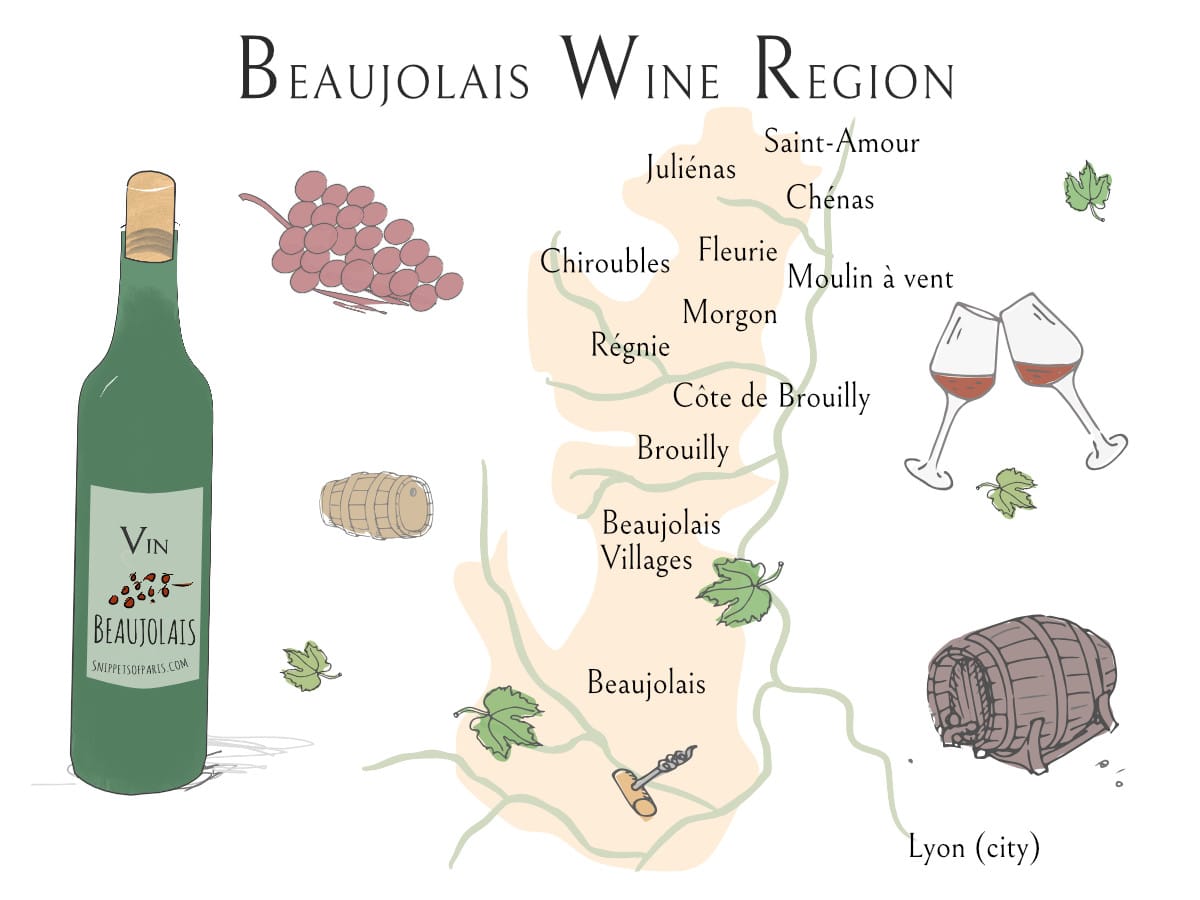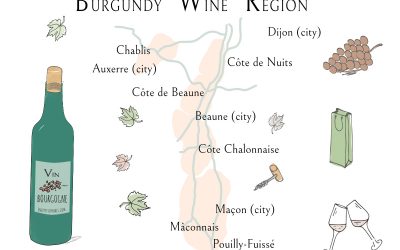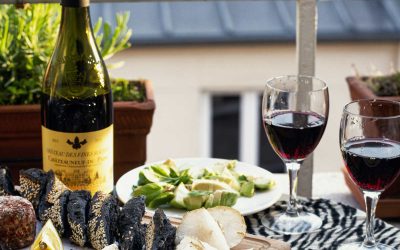Beaujolais wines, and in particular the Beaujolais Nouveau, are some of the most exported French wines in the world. Every November, you will see the signs from Paris to French bars in New York: the “Beaujolais Nouveau est arrivé!” (meaning “the Beaujolais Nouveau has arrived”). The question that most French people ask however is: is the Beaujolais Nouveau actually any good?
The historical province of Beaujolais doesn’t officially exist anymore. It has long been absorbed into the neighboring region of the Bourgogne-Franche-Comté (Burgundy) region in the central-east side of France.
Officially, Beaujolais is part of the Saône-et-Loire département of Burgundy, with a portion of it in the Rhône département of the Rhône-Alpes region.
However, while neighboring Burgundy wines are known for their reputation and prestige, which is not quite the case for the Beaujolais.
Even within France the Beaujolais is sometimes quite scoffed at. And it has a reputation for sometimes producing vintages that are, frankly, not fabulous. (It does make an excellent wine for vin chaud, however.)
- Classifications: How to pick a bottle
- What grapes are used?
- What wine is the Beaujolais known for?
- Taste: Are Beaujolais wines high in tannins?
- What dishes pair well with Beaujolais wines?
- Appellations and the Best Beaujolais
- Should you chill your bottle?
- What cheeses pair well with these wines?
- Prices: Are Beaujolais wines expensive?
- Beaujolais wine route
Classifications: How to pick a bottle
First up, is the initials that are listed on a Beaujolais bottle of wine:
- AOC – Appellation d’Origine Contrôlée
- AOP – Appellation d’Origine Protégée
- Vin de Pays – Wine of France
If the wine is an AOC or an AOP, it can then be further identified with its prestige status, as follows:
- Beaujolais Crus – The best of Beaujolais, there are 10 Crus under this label, coming from one of 10 designated villages that have their own appellations: Brouilly, Chiroubles, Chénas, Côte-du-Brouilly, Fleurie, Morgon, St-Amour, Juliénas, Moulin-à-Vent, and Regnié.
- Beaujolais Village – These wines come from one of 38 villages in the area.
- Beaujolais AOC – Appellation d’Origine Contrôlée. (The Beaujolais Nouveau is sold under this appellation.)
You can find out more about reading French wine labels here.
☞ READ MORE: 17 French Social etiquette tips: Who pours the wine?
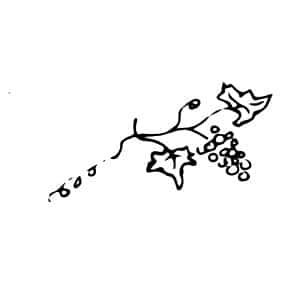
What grapes are used?
Beaujolais wines are very different from their full-bodied Bourguignon neighbors, and we should not confuse the two. The Beaujolais is usually a light red wine made principally from Gamay grapes, compared to the Burgundy which uses the Pinot Noir and Chardonnay grapes.
What wine is the Beaujolais known for?
The most popular Beaujolais is the Beaujolais Nouveau, but it is the Beaujolais crus and village wines that, these days, are attracting wine connaisseurs around the world.
The vignobles in the area dates back to the 10th century and the Dukes of Beaujeu. It became part of the royal realm of France, when King François I inherited it from his mother, Louise of Savoie. At the time Savoie was an independent duchy, with Annecy as its capital.
Being part of the royal lands belonging to the Kings of France gave Beaujolais wines easy access and a cachet to the large consumer markets of Lyon and eventually Paris.

Taste: Are Beaujolais wines high in tannins?
The gamay grapes that are the main grape in Beaujolais wines are popular because they have low levels of tannins.
The lower level of tannins (which are a naturally-occurring compound called polyphenols) means that Beaujolais wines don’t leave a dry grainy after-taste.
The red wines are relatively fresh with light fruity notes and a soft earthy undertone. Compared to a full-bodied Bordeaux or Côtes du Rhône wine for example, the Beaujolais is very easy to drink.
What dishes pair well with Beaujolais wines?
The red beaujolais wines go well with tomato sauce dishes like a lasagna or a rogail saucisse. The white wines go well with white meat like chicken. You can read more about the different wine and food pairings below.
☞ READ MORE: 14 Amusing French Wine Quotes for a little tipple
Appellations and the Best Beaujolais
1. Beaujolais Nouveau
Type: Red
Beaujolais Nouveau AOC, or “Young Beaujolais”, is one that did not have a reputation for being very good. Although it is technically part of the Region of Burgundy, it doesn’t have the same reputation as Burgundy wines. Aging doesn’t improve the wine much, and so a solution was necessary.

If you have been in France on the 3rd Thursday of November, you will have seen the signs announcing that the “Beaujolais Nouveau est arrivé!” (meaning “the Beaujolais Nouveau has arrived”).
With a bit of a makeover and a marketing push, the arrival of the Beaujolais Nouveau is marked across France as the start of the Christmas holiday season. Today, this is the most famous of the Beaujolais wines.
The Beaujolais Nouveau is an occasion to get together with friends, so share it over a charcuterie platter.
Buy a bottle of Beaujolais here.
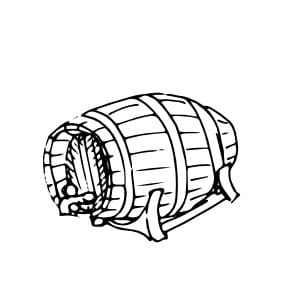
2. Beaujolais Cru
Type: Red
If you are looking for a higher-end Beaujolais, it is the Beaujolais Cru that you have to try. There are 10 types of Beaujolais Cru, with Brouilly and Côte de Brouilly being among the most well known.
The vineyards are planted on the slopes and around Mount Brouilly, giving them their name.
The Brouilly wines have an aroma of plums, strawberries, and red currents. The wine is meant to be imbibed when it is young. You can serve it with a light pasta dish, such as lasagna.
The other Crus to look out for are:
- Chénas AOC
- Chiroubles AOC
- Fleurie AOC
- Juliénas AOC
- Morgon AOC
- Moulin-à-Vent AOC
- Régnié AOC
- Saint-Amour AOC
Buy a bottle of Fleurie and Morgon here.
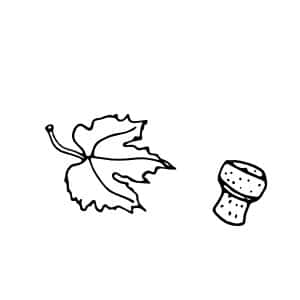
3. Beaujolais Blanc
Type: White
From the chardonnay grape, the Beaujolais Blanc AOC has a light citrus taste. It is the only white wine in this area.
The Beaujolais Blanc goes well with lighter meals like a roasted chicken with fries.
Buy a bottle of Beaujolais Blanc here.

4. Beaujolais Rosé
Type: Rosé
The Beaujolais Rosé has light raspberry notes and is wonderful when served chilled on a warm summer’s day.
It isn’t the most famous of the Beaujolais wines, and is not as popular as the Côtes du Provence rosés, but it is still widely imbibed. Why not serve it with a cake salé (savory cake) as an accompaniment?
Buy a bottle of Beaujolais Rosé here.
Should you chill your bottle?

Yes, the white wines from this region are usually served chilled.
The red wines are not usually cooled, but if you do wish to, you can cool the bottle lightly in an ice bucket (avoid the fridge), to be served at slightly below room temperature.
What cheeses pair well with these wines?
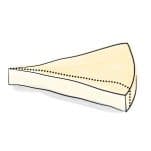
Beaujolais wines easily go with many cheeses, one favorite pairing is with soft cheeses like the gruyère. You can read more about French cheese and wine pairings here.
Prices: Are Beaujolais wines expensive?
Beaujolais wines are very reasonably priced, compared to other French wines.
Unlike Bordeaux and Burgundy wines grand crus which reach stratospheric prices due to vintages being kept for years, if not decades, the most Beaujolais wines will max out at a few hundred dollars in price.

Beaujolais wine route
Beaujolais is right in the heart of France, next to the city known as the gastronomical capital of France: Lyon. With many famed chefs working in Lyon, locals wines like the Beaujolais have been pushed to the forefront.
With beautiful medieval villages and haute cuisine nearby, a visit to the Beaujolais region is definitely worth your time. You can find more about tours and tour companies here.

So have you tried other wines from the area, rather than the Beaujolais Nouveau? If the Beaujolais Nouveau is your only impression of this region, I suggest giving a Beaujolais Cru or a Beaujolais Village a try. If you enjoyed that article, you may want to read more about wine and cheese pairings here.
But remember as always the French Government advisory, “the abuse of alcohol is dangerous for your health. Consume with moderation.” A bientôt!
